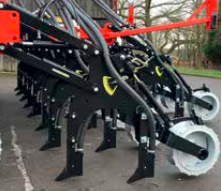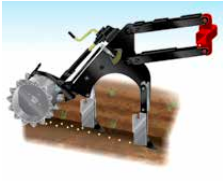
This summer has been yet another busy one for us, with drill building in full swing. It has, as always, been punctuated with exhibitions including Cereals and Groundswell. A great opportunity for us to discuss our machines with potentially new customers, we always make the most of the shows and try and speak with everyone who visits our stands. These discussions are often varied and always interesting, however there are certain common questions we are asked, the most frequent being:
So why tines and not discs?’
It is clear that both openers have their advantages and obviously as a tine drill manufacturer, we are biased. That said, our preference for tines is considered and the following is our reasoning behind this choice. We believe the three main differences between tines and discs are: Disturbance, Weight, Cost
Disturbance
It goes without saying that narrower tines working to a shallower depth will reduce disturbance. Disturbance of a tine can also be reduced by reducing the forward angle of the point. Taken to the extreme, a backward facing point would have very low disturbance, but clearly would be more inclined to smear the soil and would create compaction within the bottom of the seed row. The leading edge of a disc could be argued to be the same as a backward facing tine.

The additional disturbance of a tine is said to be not desirable due to the potential for weeds, such as blackgrass, to be more likely to germinate. If weeds such as blackgrass are a problem, agronomists are likely to encourage delayed autumn sowing and a large herbicide stack. Delaying drilling in the autumn normally means sowing into wetter soils, where narrow, forward facing tines (such as the Eco Tine) avoid smearing and ensure seed is properly covered over. The covering of the seed being essential in preventing loss of vigour from residual herbicides being sprayed onto the seeds.
Our Eco Tine is designed to create the optimum amount of soil disturbance, placing seed into fine tilth which can be consolidated around it, ensuring good seed to soil contact, whilst preventing smearing of the soil. All of this is achieved using a 12mm wide tine with a forward facing angle drilling down to approx. 10mm below seeding depth.
Weight
The action of pulling a forward facing tine through the ground creates a downward force, holding the tines in the soil. On the other hand the leading edge of a disc is always having to be ‘pushed’ down into the ground. As a result significantly less weight is required to gain and maintain penetration with a tine opener compared to a disc. Not needing to be as heavy is a significant plus, particularly in no till situations where compaction of the soil should be avoided at all costs.

Not requiring excessive coulter weight allows for wider working machines and comparatively smaller tractors can be used to pull them. This reduces the amount of soil trafficked and the overall weight put over the soil, significantly reducing soil compaction. Wider and lighter seed drills are best suited to delayed autumn drilling as they offer higher output to ensure drilling is completed in potentially tighter ‘weather windows’ later in the autumn, whilst also avoiding excessive weight on potentially wet soils susceptible to compaction.
Cost
With no moving parts a tine coulter does not require a bearing, making it a cheaper and more simple option. The Eco Tine is constructed from Boron Steel and is tipped with Tungsten Carbide which combine to offer an average life of 500ac/m of drill (a 6m Eco will drill approx. 3000ac on one set of tines, although this can vary depending on factors such as soil type, etc.).
Less frequent replacement of wearing parts along with a more simple process to replace them, ensure tines offer further savings.
Dale Drills will be exhibiting at the Midland Machinery Show & Croptec in November.